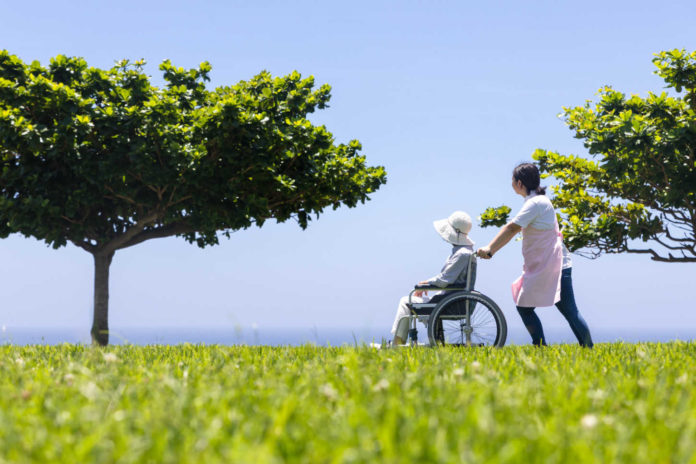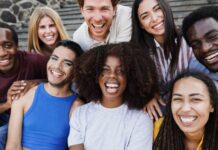
Acting as primary caregiver for a dying parent is a heavy burden for anyone. Martin, who preferred not to use his last name, assumed that role for his mother after outliving his own cancer prognosis by 20 years. Yet Martin remains remarkably upbeat while candidly discussing his experiences giving and receiving care.
From the start, Martin felt the responsibility of caring for his terminally ill mother fell to him because he was single. “There seems to be a lot of families that treat their LGBT children differently than their [heterosexual,] married children,” said Martin, a gay man “of a certain age.” It was assumed he had fewer responsibilities. “They’re from the heterosexual-normative lifestyle, and they’re used to the thought, that my family is different, my family doesn’t really exist.”
Being gay was “undiscussed,” Martin said. And because he didn’t have a partner at the same time that his mother was sick, Martin was left to pick up the slack.
“That included making meals, visiting her every day, spending hours helping her to get dressed, undress, go to the bathroom — doing the things caregivers do,” Martin said. When she entered assisted living during her final months, Martin visited her every day, keeping her company and “making sure her life was easier,” he said.
Bile duct cancer is rare, and in Martin’s mother’s case, particularly aggressive. Martin said he felt fortunate to have those six months caring for his mother because “all the things that had gone unsaid were said.”
Perhaps Martin was such a dutiful caregiver to his mother because he recalled his own experience dealing with cancer alone when he was diagnosed in 1999. For one thing, he didn’t share much about it with his family. With LGBTQ+ people, “family members don’t necessarily know or want to know what’s going on,” Martin said.
“They did not realize how sick I was,” Martin continued. “And me being who I am, I did not tell people. I would just go to my chemo…drive myself for blood transfusions, do all sorts of things that most people actually have caregivers for, like cleaning the house — even though I am sick as a dog. Because I have to… Because there’s no one else to do it.”
Martin did have a network of friends he could rely on for some things. “Being a gay guy of a certain age, my lesbian friends were very supportive,” he said. “But there’s a difference between being supported in doing things and being a true caregiver.” He said they made his life easier, but it wasn’t until he cared for his mother that he realized how much work was involved in caregiving.
For the purposes of this article, “caregiving” is defined as providing unpaid emotional, physical and sometimes financial support to a sick individual: In general, ensuring that everyday needs are met. Some research suggests caregiving became common within the LGBTQ+ community during the HIV/AIDS crisis due to stigma surrounding the illness.
Among the LGBTQ+ community, caregiving is far more common than many realize. Data from a 2014 study reveals one out of every six U.S. adults serve as unpaid caregivers to a sick adult. The rate is nearly double for LGBTQ+ adults; one in three serve as caregivers. There are many factors at play. For example, among older LGBTQ+ adults, there is an increased likelihood of living alone and being single, and a decreased likelihood of having the support of children.
Whether it’s a single LGBTQ+ person caring for an aging parent or a chosen family caring for a friend, the scenarios Martin described are not unique. Like Martin, Lauren Corneliussen identifies as a member of the LGBTQ+ community and was a caregiver to a dying loved one. But unlike Martin, Corneliussen, who is nonbinary and uses they/them pronouns, lost their partner. Tragically, they were high school sweethearts and Corneliussen was left an unmarried widow/er in their 20s. Today they are 28.
But don’t call Corneliussen brave. “Alex hated being called brave,” Corneliussen said, referring to their partner, who was bisexual and used he/him pronouns. “Because of my age, everybody expected me to bail,” they said. But Corneliussen stayed by Alex’s side until the end.
As Corneliussen recalled, it was around 2015 that Alex said to them, “My tongue hurts a little bit.” He delayed seeking treatment. And after the first doctor misdiagnosed him with a sexually transmitted infection, a proper diagnosis and treatment were delayed even further.
That’s one thing that can be called “typical” in Alex’s case: Research has shown that when someone has one experience of healthcare discrimination, they are three times more likely to postpone care in that year. By the time he did receive a proper diagnosis, he was facing stage 4 cancer. And Corneliussen was faced with being a caregiver. It helped that Alex had a supportive family, but they didn’t live nearby.
Cornesliussen feels fortunate they were able to participate in Alex’s medical care within the health system. “For the record, my partner presented as male and I presented as female,” Corneliussen said. “And so we were able to pass as heterosexuals and cisgender people through the medical system in a way that constantly benefited us.”
Corneliussen remarked that they were always shocked by how often they were able to enter rooms and get privacy notices waived by simply stating they were Alex’s fiancée. And while that enabled Corneliussen to make life-saving decisions for him, it was painful to feel forced to lie about their identity to participate in their partner’s medical care. “I would say that the way that queerness affected us had more to do with distrust of systems, distrust of the medical system,” Corneliussen said.
Caregiving can be complex, and as Martin and Corneliussen’s stories illustrate, it can be especially fraught for LGBTQ+ people. Whether family dynamics or discrimination by the healthcare system is at play, LGBTQ+ caregivers and those going through the grieving process often find appropriate support is lacking or hard to find.
Forrest Hosea is tackling a piece of the puzzle. Hosea, who uses they/them pronouns, works in the office of Cancer Health Equity and Community Engagement at the Barbara Ann Karmanos Cancer Institute. Martin and Corneliussen are members of the LGBT Cancer Action Council (CAC) that Hosea facilitates, which brings together cancer survivors, caregivers, advocates and representatives from community-based organizations. Throughout Michigan, the Karmanos Cancer Institute has eight different CACs based on geographic location or racial or ethnic identity.
“[The CACs’] knowledge and experiences are super vital in creating this targeted research and programming to improve cancer outcomes in our local communities,” Hosea said.
The importance of caregivers can’t be overstated. “There’s a lot of studies that show that without a cancer caregiver, cancer patients tend to not do as well [in] treatment,” they said. “They tend to have a less likely success rate of recovering.”
The group is working to tailor a previously successful cancer caregiver and patient support program to support LGBTQ+ people, with an emphasis on LGBTQ+ cancer caregivers. Because there are fewer support programs specifically focused on such individuals, the LGBT CAC members have made this a top research priority.
Hosea described how the healthcare system sometimes falls short when it comes to LGBTQ+ cancer caregiving. They said CAC members expressed a desperate need for LGBTQ+ education and understanding in cancer care providers. Specifically, there is a need for providers to be able to combat their own negative biases towards LGBTQ+ people. Hosea said this can be seen in body language or insensitive comments.
“If they’re already experiencing discrimination from their providers, even just in these subtle, subconscious ways, it’s very unlikely that the patient or the caregiver would be willing to actually talk about any other medical or mental health issues that they’re having,” Hosea said.
Hosea emphasized the LGBT CAC is not itself a support group, although positive feedback from group members shows it is having a positive impact on their journeys. They said members have described the group as “cathartic” and feel that their caregiving experiences are being put to a good use.
“We’re doing a lot of really good work,” Corneliussen said. “I like to make sure that people know about it so that once we get things running off the ground more and more and more, more people can be helped.”
Martin added, “There’s a lot more stuff you can do and be proactive in your care and in caring for someone else. That was the amazing thing [about] the Cancer Action Council for the people on it. It’s very healing also, ’cause you [can] discuss things that go unsaid.”
The CAC has been beneficial for Hosea, too.
“I love being able to work with other queer and trans folks at the top of all things because, as a trans and queer person myself, I can at least relate on the level of worrying about health care discrimination,” they said.
Corneliussen noted that “dying is so much logistics” and that end-of-life care can be particularly complicated for LGBTQ+ community members. There are variables like wills and funeral arrangements in an environment — whether legal or familial — that doesn’t always recognize LGBTQ+ relationships.
Since Alex passed, Corneliussen has found support in the form of Facebook groups. They said they belong to “about 50” and haven’t felt a need to seek out LGBTQ-specific ones.
“They’ve all been surprisingly very welcoming to LGBT people: young widowers, as well as unmarried widows,” Corneliussen said. “Something that we had a lot of concern about was the people being able to establish the legitimacy of our relationship after his death, and I was happy to learn that there is a large unwedded widow community.”
Other virtual options include chat rooms and forums on websites like Grief in Common. Founder and grief coach Karyn Arnold pointed us to one of the group’s many online forums, LGBTQ Loss. Arnold runs six-week programs for those who have lost a partner, but not an LGBTQ-specific program. She said she is open to ideas and feedback about offering additional support for the LGBTQ+ community.
Online communication isn’t everyone’s cup of tea. An in-person group, printed guide or a website with links to resources is a better approach for some. The Alzheimer’s Association has a page dedicated to LGBTQ+ resources, for example. SAGE USA offers numerous downloadable guides and caregiving factsheets in PDF form, and the AARP offers a “Prepare to Care Guide.”
Judy Lewis is the training and education manager for SAGE Metro Detroit, which serves the aging LGBTQ+ adult community through training, advocacy, programs and information.Lewis recommends numerous guides and directories that could benefit older LGBTQ+ caregivers; the main hurdle, she said, is getting them into people’s hands.
The free SAGE Metro Detroit “2020-2021 Rainbow Resource Guide for LGBTQ Older Adults” provides listings for inclusive businesses and services, such as community centers, senior housing and advocacy organizations and indicates which organizations have nondiscrimination policies inclusive to LGBTQ+ people.
The organization also offers a Friendly Caller Program to combat loneliness and isolation.
For those who do seek out support, finding visible allies can be an obstacle. “My whole function over these last several years is to create an army of allies,” Lewis said. “So that’s what SAGE’s total function is: to spread the word that there are a lot of allies out there, and there are a lot of resources out there.”
When Lewis was asked whether Affirmations LGBTQ Community Center or SAGE might one day offer a group specifically for LGBTQ+ caregivers or for those grieving the loss of a loved one, she said she couldn’t imagine why not.
“Because of the partnership that we have with Affirmations, and how open they have been to welcoming ideas for older adults, I can’t see why there would be any issue in terms of a live discussion group or bereavement group.”








